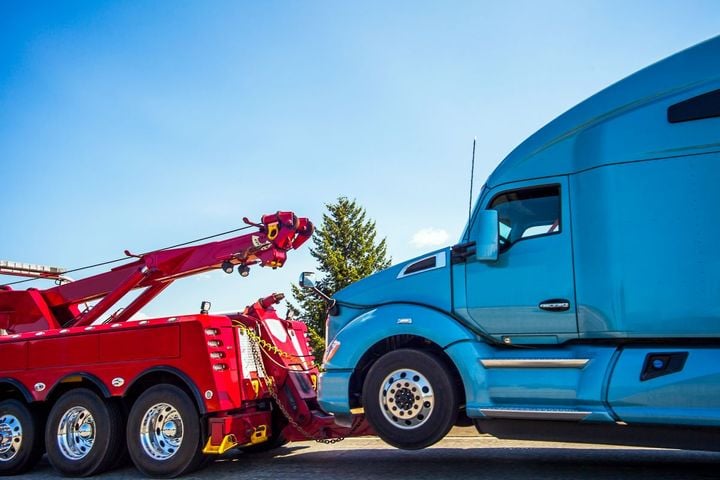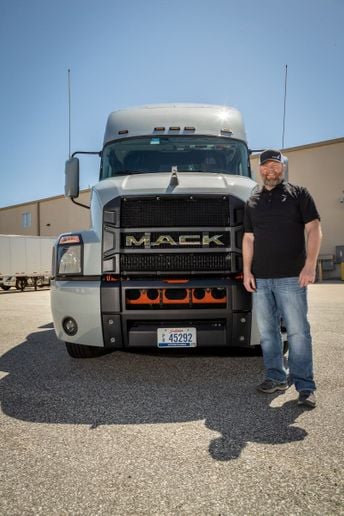Trucker Access › Forums › Diesel News › How to Manage a Truck Breakdown – Maintenance
- This topic has 0 replies, 1 voice, and was last updated 11 months, 1 week ago by
 EazyRiDer66.
EazyRiDer66.
-
AuthorPosts
-
May 17, 2024 at 4:15 pm #20902
 EazyRiDer66Keymaster
EazyRiDer66Keymaster

Fleet managers are often dealing with the unfamiliar, trusting other businesses and people to make their problem a priority.
Photo: Gettyimages.com/Siegfried Schnepf
Truck breakdowns on the road create endless headaches for maintenance managers, drivers, shippers, and receivers alike.
A remote breakdown is an immediate crisis for everyone involved. For starters, trucking companies make money by moving freight, and if the wheels aren’t turning, that truck’s not earning.
And what if the truck is carrying perishable goods? Or valuable cargo? For the truck driver, there’s not much worse than being stranded somewhere strange, all alone, wondering when help is coming.
With driver turnover at record numbers, allowing a good driver to sit and wait, feeling abandoned and uncared for, is not going to help with retention if the situation isn’t handled quickly, competently, and with sensitivity.
Both the driver and the fleet manager are often dealing with the unfamiliar, trusting other businesses and people to make their problem a priority, and hoping they don’t get taken advantage of in the process.
Truck makers try to help by providing consistent service with national dealerships, and the latest technology makes it easier for fleets to connect with those dealers.
Werner Enterprises, for example, recently partnered with Navistar to integrate International 360 (I360), a telematics and expediated repair solution, into Werner’s EDGE driver management system. Using cloud-based technology to provide real-time communications with the International service network when a breakdown occurs, Werner is able to send trucks to certified OEMs with the parts inventory to quickly get vehicles back on the road.
By offering a 10-minute time saving per repair event and reduction of data entry, the integration enables Werner’s call center team to address repair events in an average of two calls compared to a previous average of 12 calls per event. In addition, streamlined service operations offer an improved repair velocity, allowing Werner’s professional drivers to get back on the road faster with a reduced dwell time of 30% on average.
“Getting our drivers back on the road is one of the most important objectives within Werner,” said Scott Reed, senior vice president of maintenance for Werner Enterprises. “With the time savings provided by Navistar’s integration, we’re able to achieve that goal and realize the benefits across the organization, from the driver to the associate to the customer.”
Modern communication technologies — namely smartphones, telematics, and electronic logging devices — have helped tremendously in terms of speeding up response times, repairs and keeping everyone in the loop as to what’s going on. But technology only goes so far. Seasoned fleet managers have learned through trial-and-error how to best handle remote breakdowns as efficiently as possible. Here are some of the lessons learned from breakdowns far from home.
Working Out a Truck Breakdown
Darry Stuart, president of DWS Fleet Services, has been working breakdowns since before many of today’s fleet managers were even born. He remembers a time when the breakdown recovery process began with a driver hitching a ride or hoofing it down the road to find a pay phone and call somebody for help.
“In some ways, breakdowns were much simpler back then,” Stuart says. “The drivers were motivated by not wanting to take those long walks in search of a pay phone. So, they usually had tool kits with them, and they’d take care of a lot of issues on their own and then doctor the paper log books to make up the time.”
Things are different today. Modern communication means that a fleet manager often knows there’s a problem with a truck before the driver does. Stuart, however, says there’s a drawback.
“Too many fleet managers think sending an email, or calling someone on the phone, somehow shifts the burden of responsibility for the breakdown off of them and onto someone else,” he says.
But it’s still a crisis situation that must be managed very carefully. As Stuart points out, every breakdown is different. There is no one-size-fits-all solution for getting trucks back on the road.
Stuart says fleet managers have to work a breakdown all the way through from start to finish.
“Once you get the call, the text or the email that a truck is down, your focus is on the load and the driver,” Stuart says. “And you have to stay on it, and lobby and work the problem through. Because nobody else is going to do that for you.”

HellBent Xpress President and Founder Jamie Hagen loves trucking, but not maintenance. He’s happy to let Mack handle his repair work — an arrangement he says works well when a truck goes down far from home.
Jamie Hagen, founder, president and driver for HellBent Xpress out of Aberdeen, South Dakota, has built up an online presence, detailing his journey building his trucking business. Over time, his videos led to a close relationship with Mack Trucks and his becoming something of an online influencer in the industry — a role he uses to his advantage when one of his trucks goes down.
“I sort of feel bad admitting it,” Hagen says. “But when a truck goes down far from home, you’ve got to be shameless and use every tool at your disposal to get it back running.”
For Hagen, that can mean simply “sweet-talking” the person on the other end of the phone, being super-friendly and as understanding as possible.
“One time, we had an air dryer go out in North Dakota, and the local dealer had one in stock — and they weren’t going to let it go for anything,” he says. “I had a little bit of a relationship with these guys. But finally, I just said, ‘Look, I’m on the video playing in your front waiting room telling everyone how great the trucks you sell are. The least you can do is give me that air dyer!’ And it worked. Like I said, you gotta do what you gotta do.”
It’s all about relationships, Stuart stresses.
“It’s hard to do if you’re running national. But I tell regional carriers, if you find a dealer, a tow company or a repair shop that helps you out, build that relationship,” Stuart says. “Go visit them. See if they’ll stock some of your parts. And send them a gift – some Omaha Steaks, for example. This is still a relationship business. You treat people right; they’ll remember and they’ll take care of you when you need them to.”
How to Prioritize During a Truck Breakdown
The truck is down. Where do you start working the problem?
On one hand, you’ve got a load that needs to be delivered. On the other hand, you’ve got an unhappy driver sitting there wondering how he’s going to make rent. So, what do you do?
“The driver is the first priority,” Otho Ries says flatly. Ries is shop manager at Peco Food’s Pocahontas, Arkansas, fleet facility. Peco is a regional fleet, so Ries handles most breakdowns out of his own shop. But they do haul live birds and fresh eggs, which makes timely response and load management critical.
“I make sure the driver is safe, and [that they] understand we’re on the case,” he says. “Next, we’ve got to figure the load out: Do we have a trailer full of live chickens? Fresh eggs? Chicken feed? We get all of that information by talking to the driver. But, we never leave them just sitting there. If the truck is in really bad shape, then I’m sending somebody after him. In fact, I keep a CDL driver on reserve in the shop at all times. If need to, I’ll dispatch him with another tractor or just send him to bring that driver back.”
Driver and safety first, HellBent Xpress’ Hagen says.
“Being a driver myself, I’ve always approached breakdowns the way I’d want to be treated if it was me down, working for somebody else,” he says. This means breakdown pay for stranded drivers as well as comfortable lodging while issues get worked out.
“I think — more than anything else — drivers just want you to show them you care,” he says. “I think if you do that, then they’re generally willing to wait things out while you get the truck fixed.”
With the driver situated, Hagen then turns his attention to the load.
“Bottom line — we get paid for delivering loads,” he says. “So, we have a basic plan in place to make sure that happens. Sometimes we need to rent a truck. Or we’ll bobtail in to hook the trailer up. Our name is everything. So if we have to, we’ll bobtail all the way to California to get a load moving.”
Joel Morrow, senior driver and vice president of Ploger Transportation out of Norfolk, Ohio, is another social media trucking influencer with a close relationship with Volvo Trucks North America. He, too, says it’s vital to let drivers know they’re being taken care of.
“We give them layover pay, because we understand that this is beyond their control,” he says. “So, it’s critical for them to feel like they’re being taken care of.”
Even then, Ploger has no tolerance for leaving drivers stranded for extended periods of time.
“We keep a converted Class 8 wrecker here at the shop, and we’ll go get a truck anywhere,” he says. “We’ve sent it out to Nevada and California before. For one thing, we prefer to keep any maintenance work in-house if at all possible. And there’s no reason to keep a driver stranded when we can bring both them and the truck back to base. That way, they can go back to work, and we can get to work on the sick truck. The main thing is to keep them in the loop and let them know everything that is going on.”
DWS Fleet Services’ Stuart says the load and the driver both need attention.
“If you’re taking care of the load, you’re taking care of the driver, is how I’ve always seen it,” he says. “But, if you’ve got a hot load, then you need to start making decisions right away.”
The first thing Stuart does is find out where things stand with the driver’s hours of service.
“You don’t want to drag out your decision-making process too long, because if the driver runs out of hours, what could’ve been a five- or six-hour delay can turn into a 34-hour reset in a hotel room,” he explains. “I always tell fleet managers, make a decision on what you want to do, and do it fast. Don’t worry so much about whether it’s the right or the wrong call. Because you usually don’t have good options to begin with. Make a move fast and start getting the truck and the driver taken care of. Once you do that, things will start happening and you can adjust as they develop.”
Perhaps the worst part of a remote breakdown is that all the tools, talent, and training a fleet has at its disposal at home are almost completely useless. You’re often at the mercy of people you don’t know, which can lead to indecisions and second-guessing.
Outsourcing Truck Fleet Maintenance
HellBent Xpress’ Hagen loves trucking, but not maintenance. His strategy is buying and keeping extended warranties on all of his trucks and letting Mack dealers handle both routine maintenance and remote repairs.
“You get two years of GuardDog Connect [Mack’s telematics services] with an extended warranty, and then I just pony up and pay for it every year after that,” Hagen explains. “I’d rather run the trucks and let Mack take care of them. GuardDog Connect gives me everything I need to know to get a sick truck repaired. I know the engine code and have a pretty good idea of the problem. I know where the parts are. And I know which dealers can get me in. So, I don’t have to work the phones as much as in the old days. And, usually — because of the extended warranty — Mack is going to cover the cost of the repairs. It’s really been the perfect solution for me.”
Ploger’s Morrow is the polar opposite of Hagen. He’s a self-professed maintenance geek, who’d rather be in the shop tinkering with trucks than anywhere else. He takes an almost personal affront when a truck goes down.
Other than minor repairs, Morrow says he can’t stand the thought of a bunch of strangers working on one of his trucks.
“We’re a Volvo-certified shop with three Volvo master technicians in-house,” he says. “We stock our own parts and can do our own warranty work. So, it just doesn’t make any sense to me to have someone else touch our trucks. We go get them and work on them ourselves. And we feel that by doing that, we can minimize — and almost virtually eliminate — the chance of a major breakdown from occurring in the first place.”
When outsourcing maintenance, fleets have less control over cost. That’s the name of the game, DWS Fleet Services’ Stuart says.
“Take the money out of the equation,” Stuart says. “As soon as a remote breakdown occurs, most managers start worrying that they’re going to be overcharged for the repair work. And guess what? You are. They don’t know you. It’s the middle of the night. It’s freezing cold. All the stuff that goes along with all of that. They’re going to charge you a premium-and-half, just for fooling with you. It’s not fair. But it’s reality. Just get the truck going and don’t second guess things.”
This article first appeared in the November/December issue of Heavy Duty Trucking. [https://hdt.mydigitalpublication.com/publication/?i=770604]
-
AuthorPosts
- You must be logged in to reply to this topic.